
This article outlines:
Key elements of a restaurant website that will attract and retain guests
Tips for optimizing your restaurant’s Google Business and Google Maps listings
How to ensure maximum discoverability for your restaurant on social media
To remain competitive in the restaurant industry, brands of all sizes and types need to have a strong online presence. A user-friendly website, optimized Google listings, and active social media accounts increase discoverability, drive sales, and help foster long-term guest loyalty.
Here are three ways to boost your restaurant’s visibility online and drive traffic to your website:
1. Prioritize Your Restaurant Website
When people want to learn about a new restaurant today—explore the menu, find nearby locations, view order options, etc.—they’ll often start by looking at the website. And first impressions are everything.
A well-executed website has the power to convert a window shopper into a paying guest, whereas a poorly designed one can quickly drive people away. Consider your website an extension of your restaurant brand. It should mirror the brand colors, messaging, and overall vibe of your brick-and-mortar locations so anyone (existing and new guests) can get a feel for what your business is all about.
When thinking about the design of your restaurant website, put yourself in your guest’s shoes. Carefully consider their end-to-end journey. How easy or difficult is it to find your website? View the menu? Place an order? And what is the experience like on a phone? The less friction, the more likely they’ll place an order, book a reservation, or share with their friends.
You’ll have an easier time attracting and retaining guests by ensuring your restaurant website has these important features:
Key Elements Of An Effective Restaurant Website
- Responsive (mobile-friendly) design
- User-friendly navigation
- High-quality imagery
- Clear calls to action (CTAs)
- Ability to order online, make a reservation, join the waitlist, or download your mobile app
- Full restaurant menu
- Attractive, cohesive branding
- Accurate information (contact info, locations, hours, etc.)
- Social media links
- Ability to share feedback about the dining experience
- Opt-in form for email and SMS marketing
Examples Of Well-Designed Restaurant Websites
Jamba
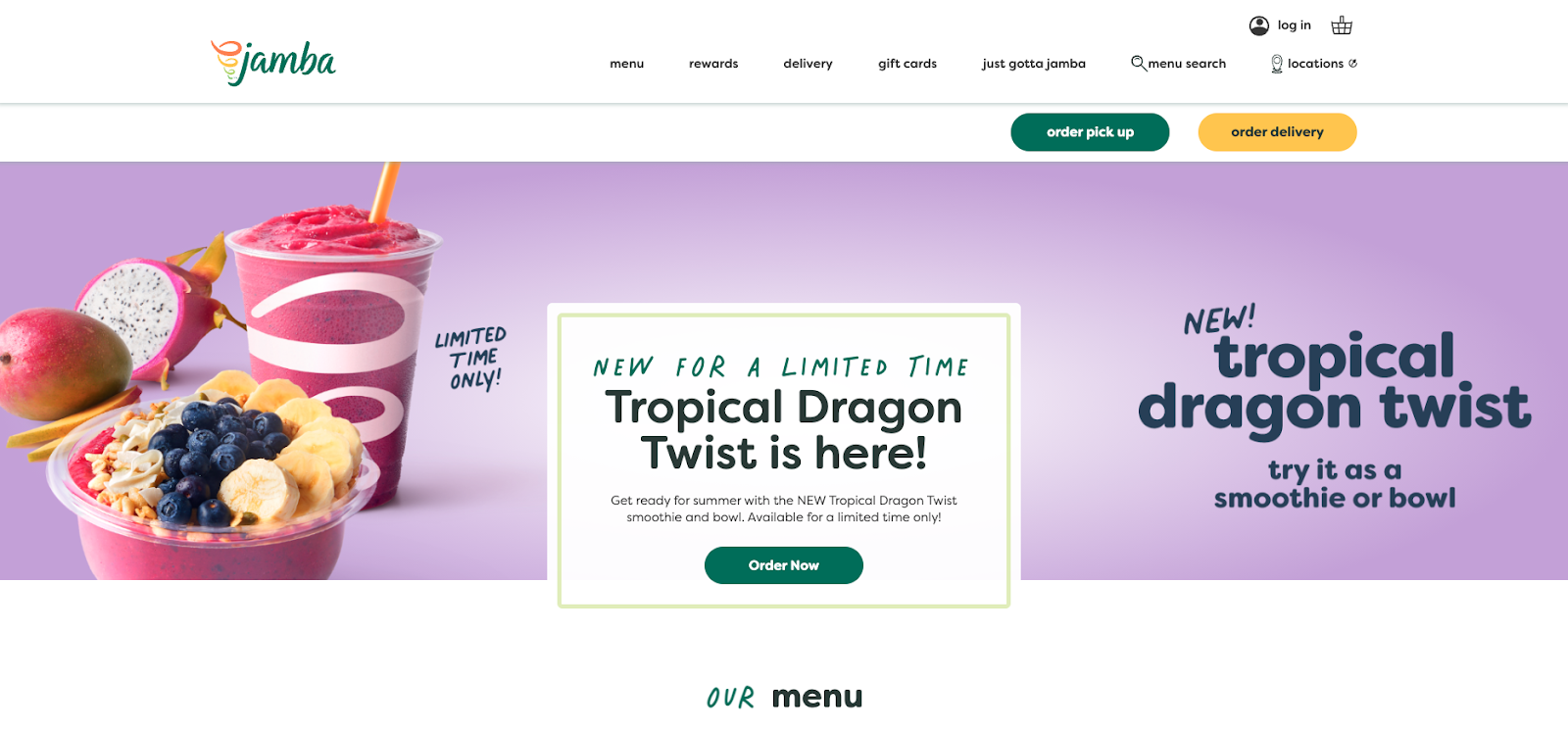
Kudos: Jamba’s website is fresh, fun, and brightly colored, just like the brand and its menu. The bold CTA buttons enable guests to quickly place a pickup or delivery order. Rewards and gift cards are also part of the main navigation for easy access. Upon scrolling, guests can download the app for a special offer, sign up for a subscription, or follow on social media.
Jeni’s Splendid Ice Creams
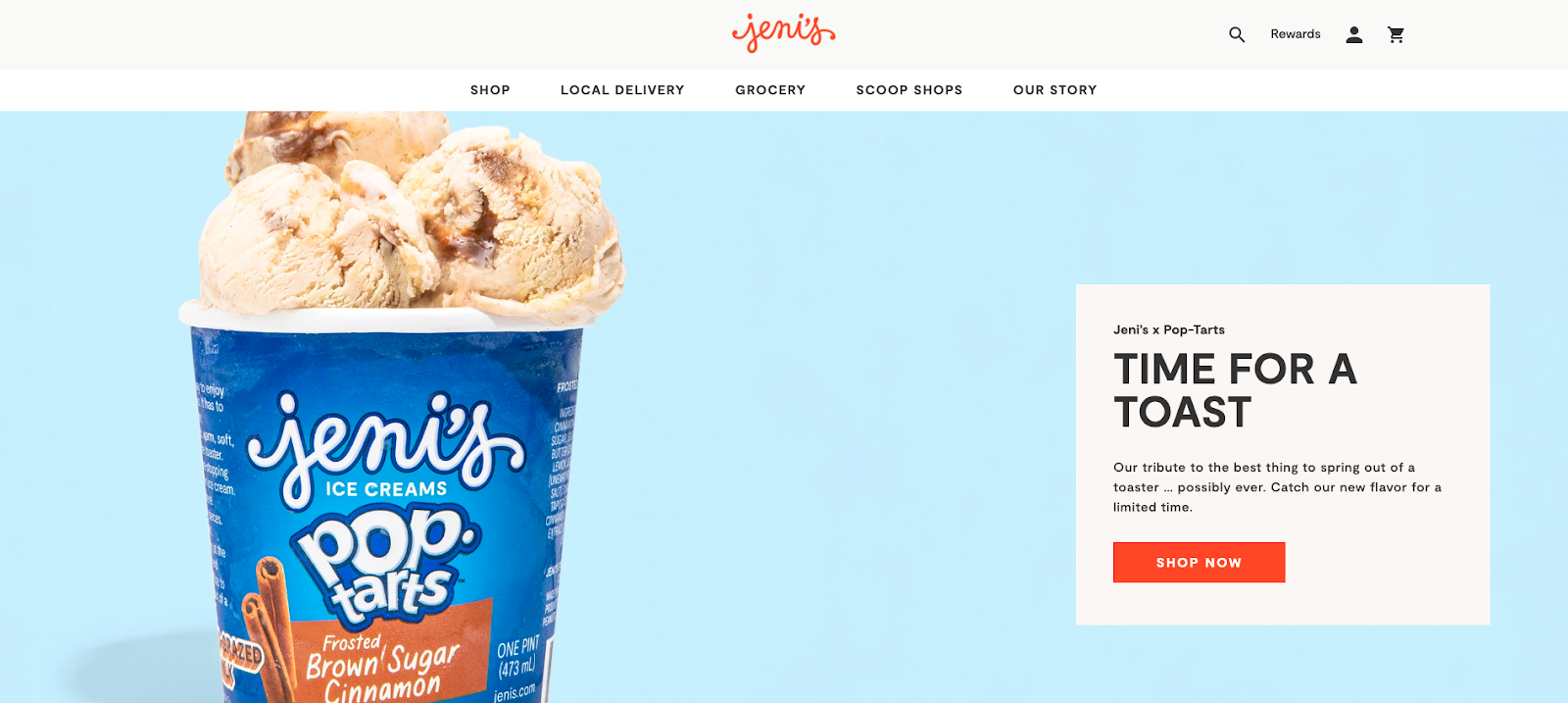
Kudos: Jeni’s website features a minimalist, on-brand design with mouthwatering imagery. The navigation is straightforward with a clear “shop now” CTA above the fold. You can easily place a delivery order from the home page, subscribe to the email list, follow on social media, and join the Pint Club.
BurgerFi
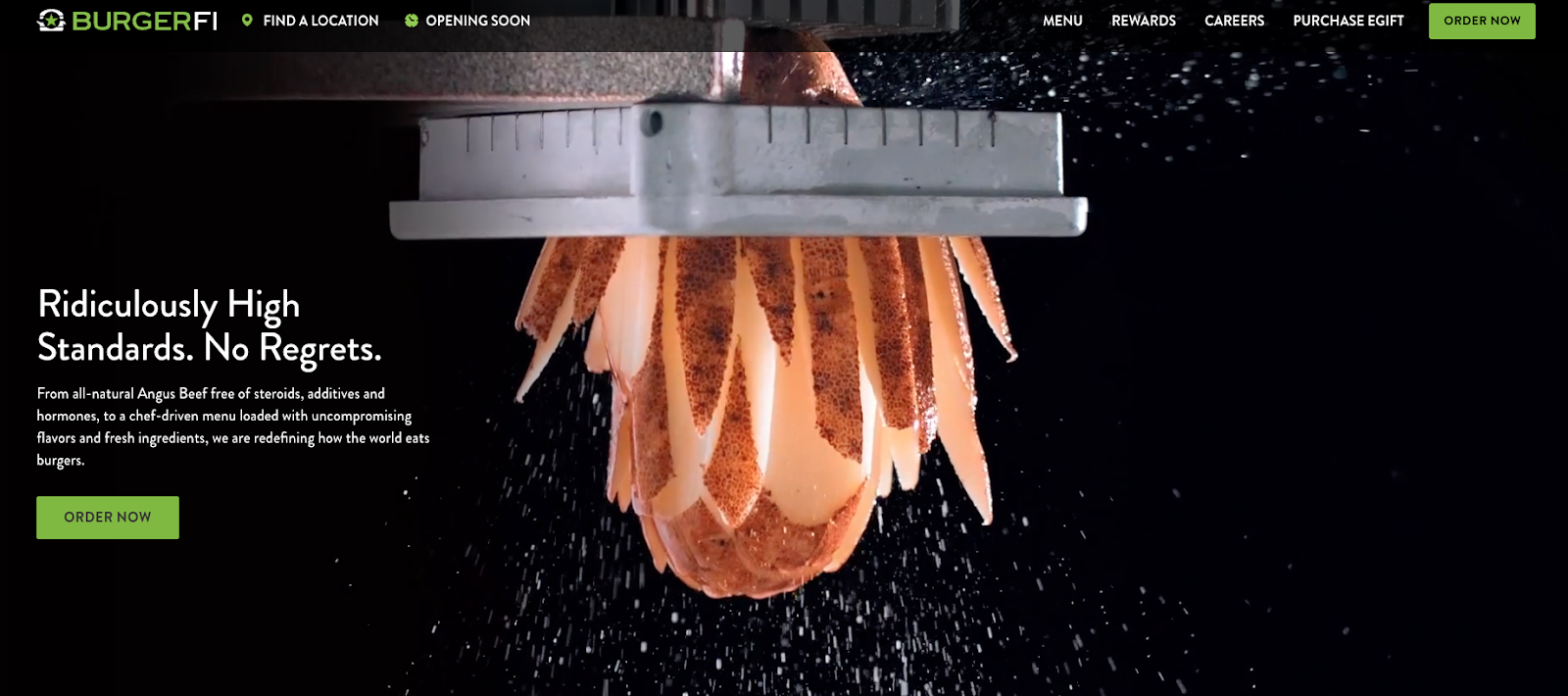
Kudos: High-quality video on BurgerFi’s homepage brings the fresh ingredients to life. The eye is drawn to the bright green “Order Now” button and everything else you might need (menu, locations, rewards, etc.) is easy to find at the top. Further down the page, you can learn about the rewards program and delivery offerings.
Maggiano’s Little Italy
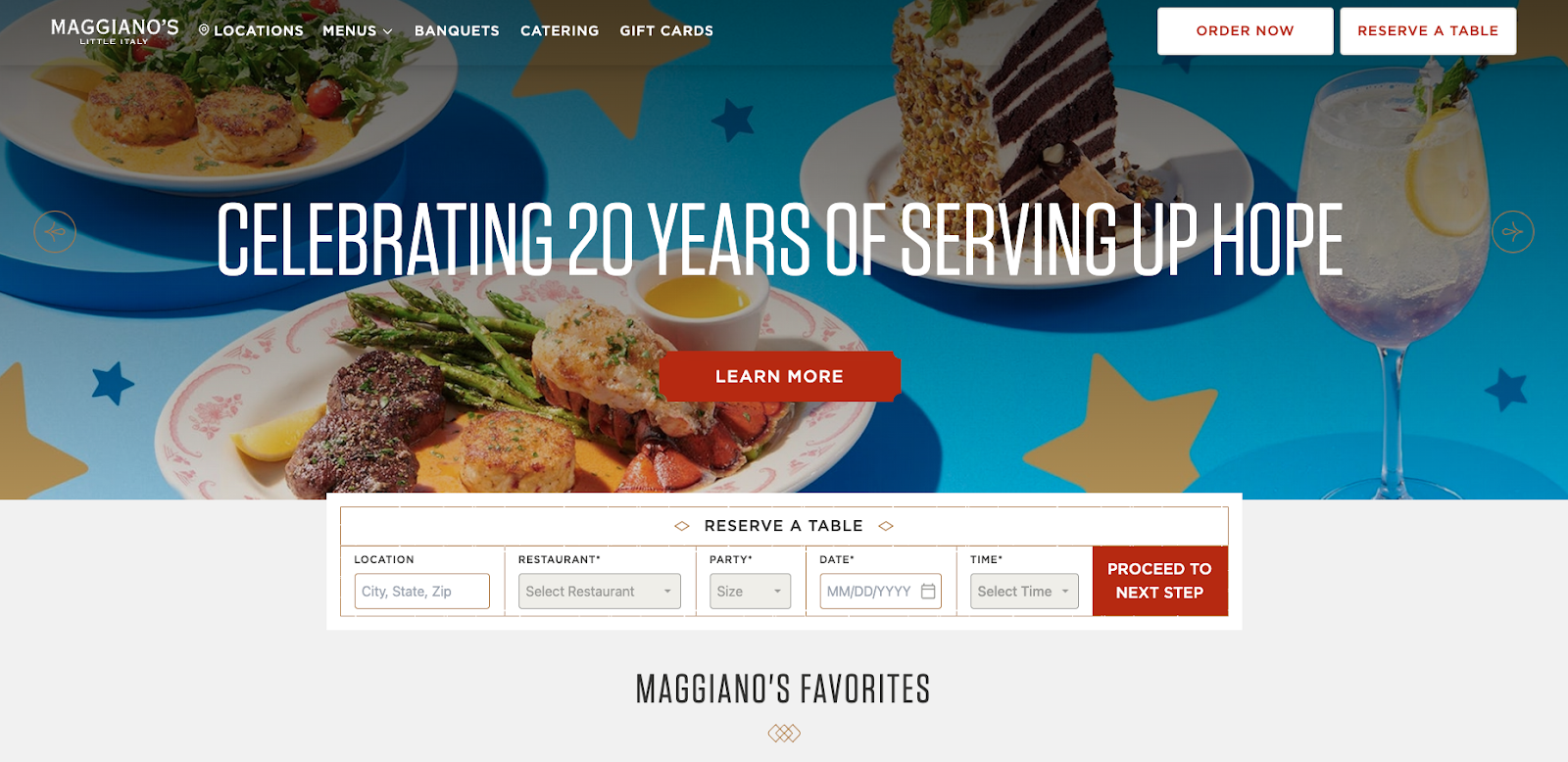
Kudos: Maggiano’s puts reservations front and center on its home page with a built-in form. Guests can also place an order from a button in the top right corner. The main navigation is straightforward and makes important pages, like the menu, easily accessible. Upon scrolling, guests will find a special offer for downloading the restaurant app, plus information about catering and banquets.
2. Optimize Your Restaurant’s Google Listings
One of the most common ways guests find places to eat today is by searching online—primarily using Google Search or Maps.
Google now owns 93% of search engine market share worldwide, and according to Google Trends data from the last five years, the search term “restaurants near me” recently reached peak popularity in July 2021.
Furthermore, a recent survey by Toast found that Google reviews (46%) was the most popular place for users to check restaurant ratings online, more popular than Yelp (23%), TripAdvisor (9%) and OpenTable (6%).
But don’t just take our word for it: Look at your guest data. When you review the sources of your online orders or cover count, how many came from Google?
You can easily increase your restaurant visibility, online orders, reservations, and more, by optimizing your Google Business listing, which is tied to your Google Maps listing. In other words, by meeting guests where they are.
But what exactly does optimize mean?
How To Optimize A Restaurant’s Google Business Listing
To rank high in Google Search results and appear in Google Maps when guests are searching for nearby restaurants, you first need to claim your Google Business profile. Be as detailed as possible when filling out your business listing.
These details include:
- Category (food type, services offered)
- Address
- Phone number
- Website
- Keyword-rich description
- Menu
- Business hours
- Logo
- Imagery
The three main factors Google considers when ranking local listings:
- Relevance: How relevant is your business listing to the search results?
- Distance: How far is your brand’s location from the searcher’s location?
- Prominence: How well-known is your brand in the offline and online communities?
The more accurate details you provide, the higher the click-through rate your listing will yield.
Leverage Olo's Order with Google Enhanced Redirect
Did you know you can offer a seamless direct ordering experience from your Google Business Profile? By leveraging Olo's Order with Google Enhanced Redirect, you can ensure guests who are using Google Search or Maps to locate similar restaurants or dishes in their area can easily find and order directly from your brand.
Olo's Google integration eliminates friction in off-premise ordering, drives traffic to your brand's website, and opens the door to new, incremental guests. Most importantly, you maintain full ownership of your guest data so you can maximize lifetime value (GLV) and put those insights to work across departments.
You can also give guests the ability to “Reserve a Table” or Join the Waitlist”—right from your Google listing. The fewer hoops guests have to jump through, the better.
Google Business is an essential platform for restaurants to communicate directly with current and potential guests by posting announcements (events, seasonal offerings, safety precautions, etc.), answering questions in the Q&A section, and responding to reviews—good and bad.
With a fully optimized Google listing, you can:
- Increase conversion (online orders, reservations and waitlist, etc.) by enabling guests to take action directly from the listing
- Appear on Google Maps when people look for restaurants nearby
- Enhance the guest experience by making it easier for guests to find information (menu, photos, reviews, answers, etc.) quickly
- Engage with guests and build trust by responding to questions and reviews
- Identify opportunities to improve service based on guest feedback and recover guests whose sentiment indicates they may be a churn risk
- Set your brand apart from the competition
Example Of An Optimized Restaurant Google Listing
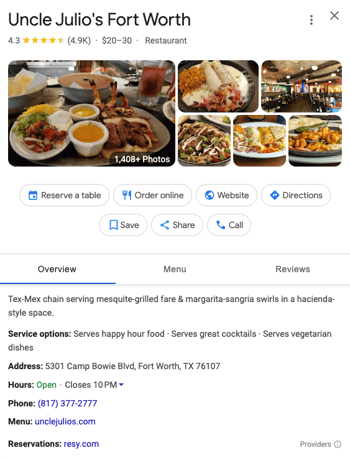
Kudos: Uncle Julio’s has fully optimized Google Business listings and leverages Olo's Order with Google Enhanced Redirect. Guests can easily view the menu and imagery, reserve a table, and order directly from the restaurant. Additionally, the brand engages with reviews, which boosts guest satisfaction and attracts potential guests.
3. Establish A Strong Social Media Presence
According to a 2023 survey by PYMNTS, 37% of diners search for restaurant information by accessing content from a restaurant’s social media page. That share jumped to 42% for Gen Z and 46% for millennials.
Needless to say, social media is a critical avenue for finding and attracting new restaurant guests. But it’s not enough to post an occasional photo. Restaurants must outline specific goals for each platform (building brand awareness, engaging directly with guests, showcasing unique offerings, etc.) and spend time cultivating a community around their brand.
Related post: 23 Restaurant Social Media Post Examples to Drive Engagement
When you’re first getting your restaurant set up on social media, think of quality over quantity. Focus your efforts on two or three major platforms so you don’t spread yourself too thin. If you’re unsure which social channels are worth the investment, consider your current guest demographics, look at referral traffic sources in Google Analytics, and survey guests with high lifetime value.
Let’s say you discover your best guests spend a good chunk of their day on Instagram. Here’s how to make your profile (and your restaurant) attractive to new and existing guests on that platform.
Start by filling out all of your Instagram profile details:
- Pick a username that accurately reflects your restaurant and is easy to remember
- Use your restaurant logo for the profile photo
- Add a link to your website
- Write a keyword-rich description and include a branded hashtag
- Set up a shop if you have merchandise
- Add the option to order food if applicable
- Add the option to send an email to the restaurant
Social Media Strategy for Restaurants
Next, create a content strategy for posting images on your feed. Here are some tips.
- Establish a posting cadence by theme: Food, drinks, people, vibe, brand story, user-generated content, etc.
- Determine what brand voice and tone you’ll use for your captions (playful, thought-provoking, punny, personable, etc.)
- Identify opportunities to engage with followers by asking questions
- Create a plan for posting consistently (e.g., at least five days per week, testing different times to measure engagement)
- Stick to your brand color palette to ensure your feed is aesthetically pleasing (dark and alluring, neutrals, bright and fun, etc.)
In addition to posting images, take advantage of all of Instagram’s features, including Stories, Reels, and Live to get guests excited about your restaurant offerings. For example, post a smoothie tutorial, poll your followers, tell the origin story of your famous queso, or do a live Q&A with everyone’s favorite bartender.
Next, create Story Highlights that will live on your restaurant’s profile for all to see. Consider highlighting menu items, locations, user-generated content, a Q&A about a seasonal offering, and chef tips.
Examples of Restaurant Brands Winning on Instagram
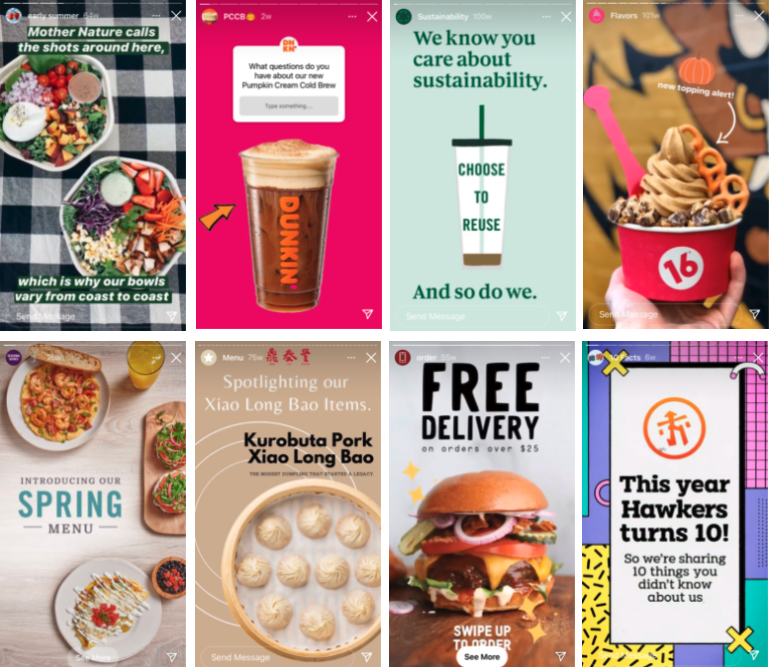
Row 1 from left: Sweetgreen showcases salad ingredients, Dunkin’ answers Qs about a seasonal drink, Starbucks outlines its commitment to sustainability, and 16 Handles reveals a new topping. Row 2 from left: First Watch unveils its spring menu, Din Tai Fung shows off its famous dumplings, Lazy Dog tells guests about free delivery, and Hawkers tells its brand story.
When it comes to curating your restaurant’s Instagram profile, consistency—from the overall look of your grid to the posting schedule—is key. In fact, 30% of millennial diners actively avoid restaurants with a weak Instagram presence.
Example Of An Optimized Restaurant Instagram Account

Kudos: Milk Bar has a fully optimized Instagram account with high-quality imagery and video that showcase the brand’s signature, brightly colored desserts. The brand uses Story Highlights to further entice visitors and the detailed description invites guests to order, look for Milk Bar at local stores, or shop the feed.
While every social media platform has unique opportunities for optimizing a profile, start with these guidelines:
- Ensure all profile details are filled out and updated as needed
- Create a clear CTA to maximize conversions (i.e., Order Online or Reserve a Table)
- Utilize relevant hashtags to increase discoverability
- Use location-based tagging when possible to help people find your restaurant
- Make it easy to contact you with questions or for more information
- Ensure all images, videos, and messaging are on-brand
- Seize the opportunity to interact with and learn from current and potential guests
- Leverage user-generated content to build a community around your brand
Taking these steps on social media will grow your following, boost brand awareness, drive traffic/orders, give regulars an easy way to advocate for your business, enable new guests to find and engage with your brand, and provide an additional digital front door to your restaurant.
Don’t Miss Out on Digital-First Guests
The importance of a strong online presence for restaurants—and businesses in general—cannot be understated. New and existing guests need to be able to find and engage with your brand quickly and easily across platforms.
Your restaurant website, Google listing, and social media accounts—or lack thereof—could be the difference between earning a guest’s business and losing it to a competitor.
Contact our team of restaurant experts to find out how Olo can help your restaurant brand boost visibility, traffic, and sales, online.
Main photo by John Schnobrich at Unsplash
